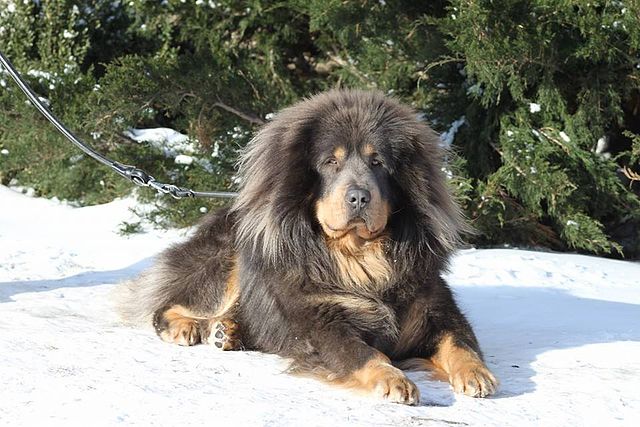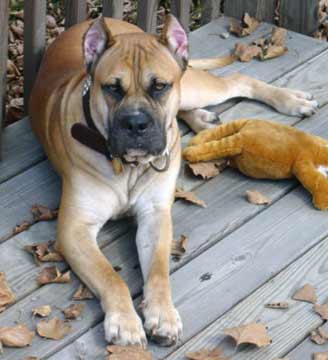The Tibetan Mastiff is a powerful breed that is still quite primitive – two traits that make him unfit for a novice owner. Slow to mature, they require heaps of socialization and training to ensure that they mature into the loyal dogs they were meant to be, rather than a liability waiting to happen. While relatively inactive indoors, they have a lot of energy to expend in the backyard, especially in the morning and evening hours. Their temperament combines the independence of a cat with the brawny protectiveness of the molosser breed that they are.
Bred to be guardian dogs, TMs are happiest when they have something to protect. They prefer to spend time both outdoors (where they can see their whole property) as well as inside with the family. They have a medium-high energy outside but a low energy when indoors. They will bark whenever they they feel something is amiss and are particularly known for being “night barkers” (when outside). Their territoriality also means that owners may have trouble letting anyone on their property – including their friends. This is why it is so important that Tibetan Mastiffs are trained and socialized early! Ultimately, while these traits can be disastrous in the wrong situation, they are excellent home protection dogs for those who can handle them.
The magnificent coat is one of the hallmarks of the breed. Tibetan Mastiffs have thick double coats that form a mane around their head, and that coat only tends to shed once a year. When they shed, however… they really shed! Your house will be covered in hair for about 8 weeks during their “big shed” and they need to be brushed constantly in order to help pull out the dead hair. Other than the shedding, TMs are generally very clean dogs and their hair is dirt-resistant. Some people with dog allergies find that they are not allergic to Tibetan Mastiffs, although this is not the case with all allergy sufferers.
Tibetan Mastiffs are highly intelligent, yet independent. They were bred to make decisions on their own. This means that they are not “push-button obedience dogs” but they are very capable of being trained. In fact, they are often fast learners! The problem comes when they do not feel like working, as they tend towards stubbornness. It is up to the owner to make sure that the dog still follows the command. If commands are rarely enforced, the owners will inadvertently teach the TM that rules have no real backing, which then signals the dog that he needs to make the rules instead. In a breed this large and powerful, rules and boundaries are essential.
The breed is patient with family children, but it is important that the kids be considerate of the dog. TMs may be more wary of strange children, in the same way that they are cautious and reserved with strange adults. When it comes to other dogs, Tibetan Mastiffs tend to act dominant to dogs they have just met. Many also display same-sex aggression. They can live harmoniously with other dogs but careful and proper introductions are necessary. If living with a dog of the same sex, there is a better outcome if the other dog is smaller than the TM. Tibetans often are great with cats and other small animals as long as they are raised with them, and as long as the animals are inside (outside, all bets are off).
Tibetan Mastiffs do not make good apartment dogs even if they are given extra exercise. The breed really needs a yard in which to stretch out and explore. As such, even a small yard is usually not enough. When outside, they should be kept in a securely fenced yard to keep them from roaming. Dogs who roam are at risk for claiming more and more territory, and then acting aggressively when an “intruder” tries to come near. Guarding the house or the yard is one thing… guarding the street is another. Some Tibetans are skilled at climbing chain link fences, so a solid wood fence is recommended. Taking the dog out for regular walks will help to satiate his curiosity about the outside world, but he should always be taken out on a leash.
Despite their tough appearance, the breed is actually very sensitive to the emotions of their owners and they do not like to be around fighting or chaos in general. Tibetan Mastiffs exposed to constant stress may become picky eaters. When the energy of the house is calm, they reflect the same mellow vibe (their natural disposition). TMs are also sensitive to change and thrive on routine schedules.
When young (particularly the first 2-3 years), many Tibetan Mastiffs can be very destructive. Those big mouths can chew through wood (including doors), fencing and furniture! This tends to happen in dogs that are bored or under-stimulated but may also happen “just for fun”. Strong jaws plus a huge frame means that TMs can do more damage in a shorter period of time than a smaller breed. Looking for a safe, non-toxic option for your Tibetan Mastiff? Check out the Benebone made with your pet’s safety in mind – https://amzn.to/410F5TG This breed also delights in digging craters in the yard.

Affiliate Disclaimer
As an Amazon Associate, I earn from qualifying purchases. This means that if you click on an affiliate link on this site and make a purchase, I may earn a small commission at no additional cost to you. Rest assured that I only link to products I have used, or use on a regular basis, and trust enough to recommend them to you!



